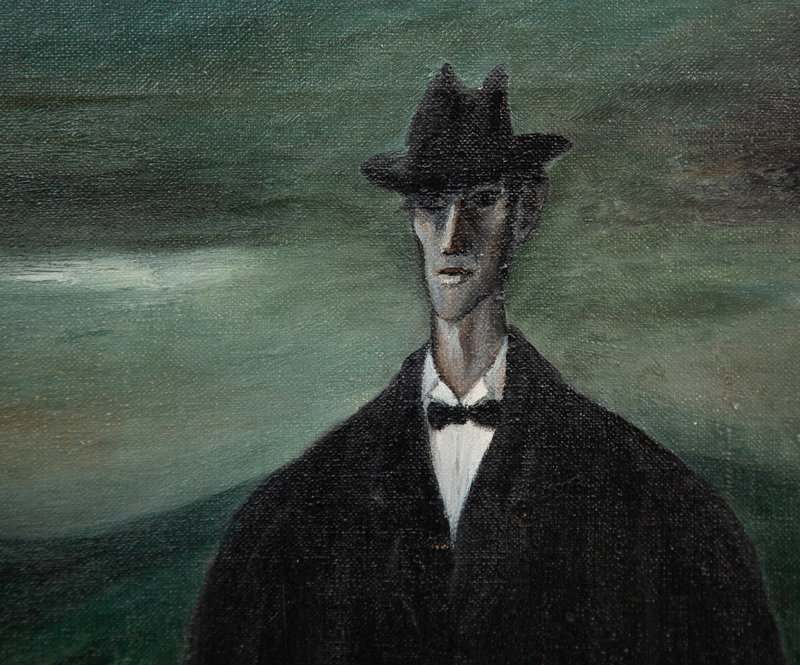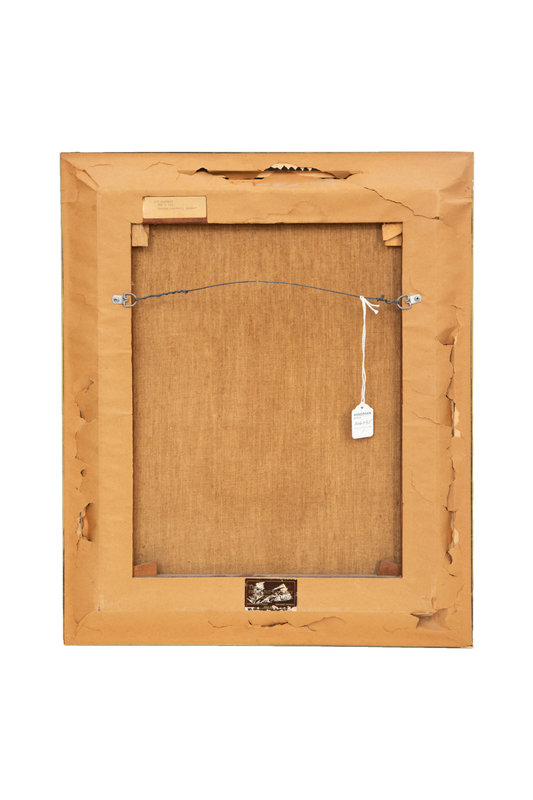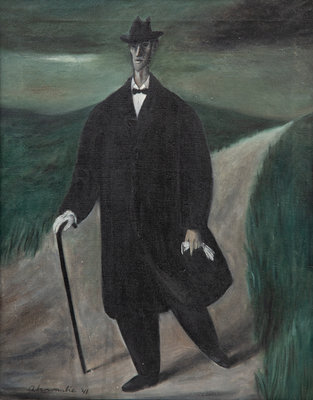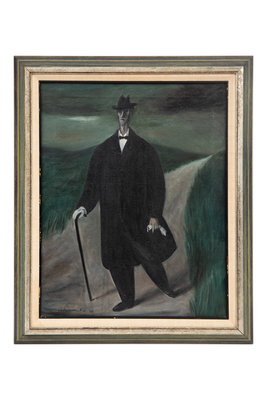Sold for $100,800
We are grateful for the research conducted by Susan Weininger, Professor Emerita, Roosevelt University.
Provenance:
The Artist
Marion (Edwards) Andreas, Chicago, acquired from the above
Gifted to the present owner by the above, c. 1974
Exhibited:
Kalamazoo, Michigan, Kalamazoo Art Institute, 1943
Milwaukee, Wisconsin, Milwaukee Art Institute, 1944
Chicago, Illinois, Art Institute of Chicago, Gertrude Abercrombie and Harold Noecker, May 11 - June 18, 1944
Chicago, Illinois, Marshall Field and Company, 1944
Chicago, Illinois, Hyde Park Art Center, Gertrude Abercrombie, A Retrospective Exhibition, January 28 - March 5, 1977, no. 26
Lot Essay:
An unusual subject in Gertrude Abercrombie’s oeuvre, John Carradine remembered from “Man Hunt,” displays the artist’s admiration for the actor John Carradine in this homage to the 1941 film Man Hunt, set in 1939. Carradine plays an agent (Mr. Jones), who is tasked with capturing an English citizen accused of attempting to assassinate Hitler, at a time when the British were desperately trying to avoid another war by appeasing the Nazis. The film was controversial for its overt anti-Nazi position in the United States prior to its involvement in World War II.
This painting, which is set against an austere landscape and a rapidly receding road, is centered on a large man who represents Carradine in his role as Mr. Jones. Abercrombie must have found this film, and John Carradine, compelling, to have made the painting such a short time after seeing it. In the 1930s, early in her career, she did many portraits, primarily of friends (many of them artists and writers), along with a few commissions. By the 1940s, she had achieved some success as an artist and had developed her signature style, incorporating objects of personal significance into landscapes, still lifes, and her unique interiors. Very few images of humans, aside from herself, appear in paintings from this time on, apart from a few commissioned portraits, an occasional image of Abe Lincoln, one or two appearances of each of her two husbands, and the figure in John Carradine remembered from “Man Hunt.” However, this is not the only image of Carradine that Abercrombie painted. In about 1942, she painted a much smaller (6 x 4 inches) version of the present scene on Masonite, titled Man Hunt. This painting was exhibited in her 1946 solo exhibition at Associated American Artists in New York and subsequently sold to an impressive trio of East Coast collectors, including Mrs. Oscar Hammerstein II.
Man in a Hat, c. 1933, an unusually large (17 x 22 1/2 inches) painting for Abercrombie may help shed some light on both Man Hunt and John Carradine remembered from “Man Hunt.” This painting remained in the artist’s possession until her death (the current location is unknown) either indicating it had some personal meaning to her or that it was not salable. The subject of this painting is a half-length man facing forward, dressed in suit and tie, and wearing a wide brimmed fedora. The image is done in an expressionist style, with shape and size distortions that lend the composition an energy that animates the stony-faced figure. The loose, visible brushstrokes in both the figure and the background also enliven the composition. This figure has an experimental quality that is characteristic of the artist’s early work and is executed in a style that does not make many appearances in her more mature paintings. The feature that is most interesting when considering John Carradine remembered from “Man Hunt” and Man Hunt, however, is the man’s features: his thin, angular, and elongated face takes up fully one third of the total height of the canvas. More than that, he is a clear match for a young John Carradine, whose very long thin face lends itself to stylization. Comparing this portrait to photographs of Carradine makes a strong argument for its identification with the actor. While both Man Hunt and John Carradine remembered from “Man Hunt” are stylistically very different from Man in a Hat, they do appear to depict the same person and may indicate an early fascination with the actor on the artist’s part.
John Carradine remembered from “Man Hunt” is painted in Abercrombie’s later, more mature style. The composition, like most of the artist’s work, is simple and unadorned, the background made up of several dark color areas. The large, streamlined figure is clothed in a black coat, pants, shoes, tie, and hat that hide the human body underneath. In the film, Carradine wore a black coat and hat and carried a walking stick like the one in the painting. Highlighted by the visible triangle of his white shirt and his white gloves, the generalized, billowy shape of the figure gives the impression of motion. The large body culminates in a small head and tiny feet, a distortion that amplifies this feeling. The elongated neck and face of the figure, although not portraitlike, convey the essential Carradine. The beautifully composed artwork, balanced both in space and surface, reveals Abercrombie’s artistic skill. The man occupies the center of the painting, his extended left leg echoed in form by the elegant cane in his right hand. The V shape of the visible part of his shirt is repeated in the head, the crease in the top of the hat, and in reverse in the shape between the pant legs, as well as the end of the receding road.
This painting offers some of the mystery seen so often in the artist’s mature works and offers a rare example of a portrait of a person who was not a friend or acquaintance. Carradine, often cast as a villain, embodies the ambiguity that is characteristic of the best art. The film, and the actor, certainly meant something to Abercrombie, who asserted that, “It is always myself that I paint,” even when she herself is not present in the work. John Carradine remembered from “Man Hunt” is a striking painting, unique and mesmerizing, and is an outstanding example of the artist’s oeuvre.









